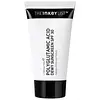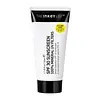What's inside
What's inside
 Key Ingredients
Key Ingredients

 Benefits
Benefits

 Concerns
Concerns

 Ingredients Side-by-side
Ingredients Side-by-side

Water
Skin ConditioningOctocrylene
UV AbsorberGlycerin
HumectantEthylhexyl Salicylate
UV AbsorberCoco-Caprylate/Caprate
EmollientButyl Methoxydibenzoylmethane
UV AbsorberPhenylbenzimidazole Sulfonic Acid
UV AbsorberTriheptanoin
Skin ConditioningSaccharomyces Ferment
Skin ConditioningCetearyl Alcohol
EmollientGlyceryl Stearate Se
EmulsifyingTromethamine
BufferingGlyceryl Caprylate
EmollientPropanediol
SolventC9-12 Alkane
SolventDilinoleic Acid/Butanediol Copolymer
Sodium Stearoyl Glutamate
CleansingHydroxyethyl Acrylate/Sodium Acryloyldimethyl Taurate Copolymer
Emulsion StabilisingDimethicone
EmollientSqualane
EmollientHectorite
AbsorbentLauroyl Lysine
Skin ConditioningHydroxyethylcellulose
Emulsion StabilisingCaprylhydroxamic Acid
Dimethiconol
EmollientPolysorbate 60
EmulsifyingAcrylates/C10-30 Alkyl Acrylate Crosspolymer
Emulsion StabilisingOryza Sativa Hull Extract
MoisturisingCastor Oil/Ipdi Copolymer
Phenoxyethanol
PreservativePolyglutamic Acid
Skin ConditioningSorbitan Isostearate
EmulsifyingCamellia Sinensis Leaf Extract
AntimicrobialIpomoea Batatas Root Extract
Skin ConditioningHydroxyacetophenone
AntioxidantSodium Benzoate
Masking1,2-Hexanediol
Skin ConditioningCaprylyl Glycol
EmollientLactobacillus Ferment Lysate
Skin ConditioningSaccharomyces Lysate
Skin ConditioningWater, Octocrylene, Glycerin, Ethylhexyl Salicylate, Coco-Caprylate/Caprate, Butyl Methoxydibenzoylmethane, Phenylbenzimidazole Sulfonic Acid, Triheptanoin, Saccharomyces Ferment, Cetearyl Alcohol, Glyceryl Stearate Se, Tromethamine, Glyceryl Caprylate, Propanediol, C9-12 Alkane, Dilinoleic Acid/Butanediol Copolymer, Sodium Stearoyl Glutamate, Hydroxyethyl Acrylate/Sodium Acryloyldimethyl Taurate Copolymer, Dimethicone, Squalane, Hectorite, Lauroyl Lysine, Hydroxyethylcellulose, Caprylhydroxamic Acid, Dimethiconol, Polysorbate 60, Acrylates/C10-30 Alkyl Acrylate Crosspolymer, Oryza Sativa Hull Extract, Castor Oil/Ipdi Copolymer, Phenoxyethanol, Polyglutamic Acid, Sorbitan Isostearate, Camellia Sinensis Leaf Extract, Ipomoea Batatas Root Extract, Hydroxyacetophenone, Sodium Benzoate, 1,2-Hexanediol, Caprylyl Glycol, Lactobacillus Ferment Lysate, Saccharomyces Lysate
Water
Skin ConditioningZinc Oxide
Cosmetic ColorantCaprylic/Capric Triglyceride
MaskingDicaprylyl Carbonate
EmollientCoconut Alkanes
EmollientGlyceryl Stearate
EmollientCaramel
Cosmetic ColorantGlycerin
HumectantSilica
AbrasivePEG-100 Stearate
Polyhydroxystearic Acid
EmulsifyingDimethicone
EmollientGlyceryl Stearate Citrate
EmollientPolymethylsilsesquioxane/Silica Crosspolymer
Potassium Cetyl Phosphate
EmulsifyingStearic Acid
CleansingPhenoxyethanol
PreservativePolyglyceryl-3 Stearate
EmulsifyingCoco-Caprylate/Caprate
EmollientSodium Stearoyl Glutamate
CleansingHydrogenated Lecithin
EmulsifyingHydroxyethyl Acrylate/Sodium Acryloyldimethyl Taurate Copolymer
Emulsion StabilisingPolysilicone-11
Squalane
EmollientBisabolol
MaskingButyrospermum Parkii Butter
Skin ConditioningTocopheryl Acetate
AntioxidantXanthan Gum
EmulsifyingCitric Acid
BufferingAloe Barbadensis Leaf Juice Powder
Skin ConditioningEthylhexylglycerin
Skin ConditioningPanthenol
Skin ConditioningLecithin
EmollientPolysorbate 60
EmulsifyingTrisodium Ethylenediamine Disuccinate
1,2-Hexanediol
Skin ConditioningTocopherol
AntioxidantAscorbyl Palmitate
AntioxidantSorbitan Isostearate
EmulsifyingBiosaccharide Gum-4
Skin ConditioningHelianthus Annuus Seed Oil
EmollientWater, Zinc Oxide, Caprylic/Capric Triglyceride, Dicaprylyl Carbonate, Coconut Alkanes, Glyceryl Stearate, Caramel, Glycerin, Silica, PEG-100 Stearate, Polyhydroxystearic Acid, Dimethicone, Glyceryl Stearate Citrate, Polymethylsilsesquioxane/Silica Crosspolymer, Potassium Cetyl Phosphate, Stearic Acid, Phenoxyethanol, Polyglyceryl-3 Stearate, Coco-Caprylate/Caprate, Sodium Stearoyl Glutamate, Hydrogenated Lecithin, Hydroxyethyl Acrylate/Sodium Acryloyldimethyl Taurate Copolymer, Polysilicone-11, Squalane, Bisabolol, Butyrospermum Parkii Butter, Tocopheryl Acetate, Xanthan Gum, Citric Acid, Aloe Barbadensis Leaf Juice Powder, Ethylhexylglycerin, Panthenol, Lecithin, Polysorbate 60, Trisodium Ethylenediamine Disuccinate, 1,2-Hexanediol, Tocopherol, Ascorbyl Palmitate, Sorbitan Isostearate, Biosaccharide Gum-4, Helianthus Annuus Seed Oil
 Reviews
Reviews

Ingredients Explained
These ingredients are found in both products.
Ingredients higher up in an ingredient list are typically present in a larger amount.
1,2-Hexanediol is a synthetic liquid and another multi-functional powerhouse.
It is a:
- Humectant, drawing moisture into the skin
- Emollient, helping to soften skin
- Solvent, dispersing and stabilizing formulas
- Preservative booster, enhancing the antimicrobial activity of other preservatives
Coco-Caprylate/Caprate is created from fatty coconut alcohol, caprylic acid, and capric acid.
It is a lightweight emollient. Emollients create a thin barrier on the skin to trap moisture in. This helps keep your skin hydrated and soft.
Once applied, Coco-Caprylate/Caprate is absorbed quickly and leaves a silky feel.
Coco-Caprylate/Caprate may not be fungal acne safe.
Learn more about Coco-Caprylate/CaprateDimethicone is a type of synthetic silicone created from natural materials such as quartz.
What it does:
Dimethicone comes in different viscosities:
Depending on the viscosity, dimethicone has different properties.
Ingredients lists don't always show which type is used, so we recommend reaching out to the brand if you have questions about the viscosity.
This ingredient is unlikely to cause irritation because it does not get absorbed into skin. However, people with silicone allergies should be careful about using this ingredient.
Note: Dimethicone may contribute to pilling. This is because it is not oil or water soluble, so pilling may occur when layered with products. When mixed with heavy oils in a formula, the outcome is also quite greasy.
Learn more about DimethiconeGlycerin is already naturally found in your skin. It helps moisturize and protect your skin.
A study from 2016 found glycerin to be more effective as a humectant than AHAs and hyaluronic acid.
As a humectant, it helps the skin stay hydrated by pulling moisture to your skin. The low molecular weight of glycerin allows it to pull moisture into the deeper layers of your skin.
Hydrated skin improves your skin barrier; Your skin barrier helps protect against irritants and bacteria.
Glycerin has also been found to have antimicrobial and antiviral properties. Due to these properties, glycerin is often used in wound and burn treatments.
In cosmetics, glycerin is usually derived from plants such as soybean or palm. However, it can also be sourced from animals, such as tallow or animal fat.
This ingredient is organic, colorless, odorless, and non-toxic.
Glycerin is the name for this ingredient in American English. British English uses Glycerol/Glycerine.
Learn more about GlycerinThis is a synthetic polymer. It helps improve the texture of products by adding thickness and gel-like feel.
It is also an emulsifer, meaning it prevents ingredients such as oil and water from separating. It also helps evenly disperse other ingredients.
Phenoxyethanol is a preservative that has germicide, antimicrobial, and aromatic properties. Studies show that phenoxyethanol can prevent microbial growth. By itself, it has a scent that is similar to that of a rose.
It's often used in formulations along with Caprylyl Glycol to preserve the shelf life of products.
Polysorbate 60 is used to help stabilize products. It is a surfactant and emulsifier. These properties help keep ingredients together in a product. Surfactants help reduce surface tension between ingredients with different states, such as liquids and solids. Emulsifiers help prevent oils and waters from separating.
Polysorbate 60 is sorbitol-based and created from the ethoxylation of sorbitan. Ethoxylation is a chemical reaction used to add ethylene oxide. Sorbitan is a the dehydrated version of sorbitol, a sugar found in fruits.
In this case, the 60 comes from reacting 60 units of ethylene oxide with sorbitan.
Polysorbates are commonly used in medicine and foods.
Learn more about Polysorbate 60Sodium Stearoyl Glutamate is an emulsifier and helps condition the skin. It is amino acid-based.
In higher amounts, it may act as a cleansing agent.
Sorbitan Isostearate is an emulsifer and cleaning agent. It is created from isostearic acid and sorbitol.
As an emulsifier, Sorbitan Isostearate prevents oils and water from separating.
Due to its isostearic acid base, it may not be safe for Malassezia or fungal acne.
Learn more about Sorbitan IsostearateSqualane is an emollient that helps the skin hold onto moisture. It's an oily liquid that occurs naturally in certain types of fish and plant oils.
Because squalane boosts hydration in the skin, it also comes with plenty of benefits: it is an antioxidant and can help fight free radicals and skin damage. Squalane is also found to have a detoxifying effect when applied.
Squalane comes from squalene, which occurs naturally within the sebum of our skin. It is one of the oils our skin produces to keep itself hydrated. Squalane is the hydrogenated version of squalene and has a longer shelf life.
Research shows that squalane is non-irritating (even at 100% concentration).
In general, it's a fantastic ingredient. It does a great job at hydrating the skin, and it's suitable for those with sensitive skin.
The source of squalane may impact malassezia / fungal acne. This is because olive oil derived squalane can contain impurities such as fatty acids and plant waxes. Sugarcane derived squalane is recommended for anyone with malassezia concerns.
Is squalane vegan?
This depends on the source. Squalane can be derived from both plants and animals. Most squalane used in skincare comes from plants.
Please note: the source of squalane is only known if disclosed by the brand. We recommend reaching out to the brand if you have any questions about their squalane.
Read more about squalene with an "e".
Is squalane an oil?
Squalane is often called an oil, but it’s technically not; it’s a hydrocarbon, meaning it’s only made of carbon and hydrogen, unlike true oils which are triglycerides made of fatty acids and glycerol.
The term “oil-free” isn’t regulated, so companies can define it however they want. Some exclude all oils, while others just avoid mineral oil or comedogenic oils.
While some people avoid oils thinking they cause breakouts, the right kind of oil (or oil-like ingredient like squalane) can actually help balance and hydrate your skin. It’s worth testing out simple oils or squalane to see what works best for your skin.
Learn more about SqualaneWater. It's the most common cosmetic ingredient of all. You'll usually see it at the top of ingredient lists, meaning that it makes up the largest part of the product.
So why is it so popular? Water most often acts as a solvent - this means that it helps dissolve other ingredients into the formulation.
You'll also recognize water as that liquid we all need to stay alive. If you see this, drink a glass of water. Stay hydrated!
Learn more about Water